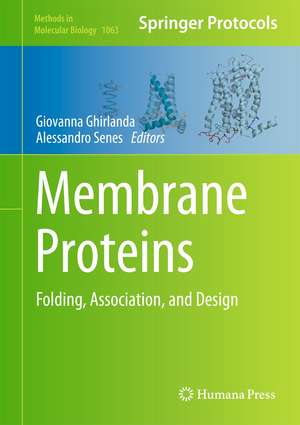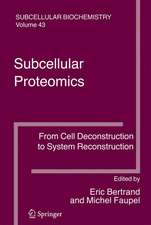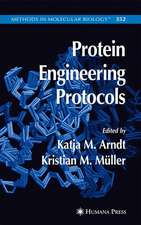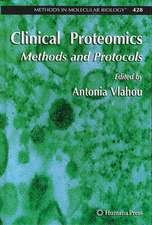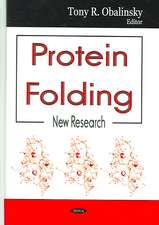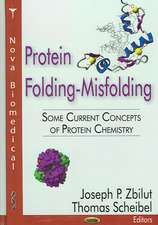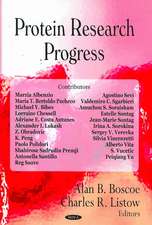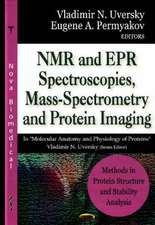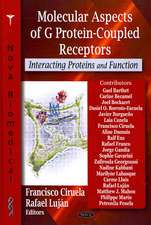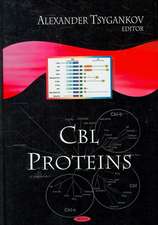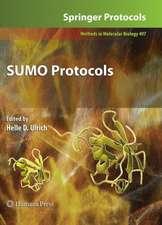Membrane Proteins: Folding, Association, and Design: Methods in Molecular Biology, cartea 1063
Editat de Giovanna Ghirlanda, Alessandro Senesen Limba Engleză Hardback – 23 aug 2013
Authoritative and practical, Membrane Proteins: Folding, Association, and Design serves as an ideal guide for researchers reaching for the tantalizing possibility of designing novel membrane proteins with tailored functionality.
| Toate formatele și edițiile | Preț | Express |
|---|---|---|
| Paperback (1) | 689.42 lei 43-57 zile | |
| Humana Press Inc. – 23 aug 2016 | 689.42 lei 43-57 zile | |
| Hardback (1) | 648.42 lei 43-57 zile | |
| Humana Press Inc. – 23 aug 2013 | 648.42 lei 43-57 zile |
Din seria Methods in Molecular Biology
- 9%
 Preț: 791.63 lei
Preț: 791.63 lei - 23%
 Preț: 598.58 lei
Preț: 598.58 lei - 20%
 Preț: 882.98 lei
Preț: 882.98 lei -
 Preț: 252.05 lei
Preț: 252.05 lei - 5%
 Preț: 802.70 lei
Preț: 802.70 lei - 5%
 Preț: 729.61 lei
Preț: 729.61 lei - 5%
 Preț: 731.43 lei
Preț: 731.43 lei - 5%
 Preț: 741.30 lei
Preț: 741.30 lei - 5%
 Preț: 747.16 lei
Preț: 747.16 lei - 15%
 Preț: 663.45 lei
Preț: 663.45 lei - 18%
 Preț: 1025.34 lei
Preț: 1025.34 lei - 5%
 Preț: 734.57 lei
Preț: 734.57 lei - 18%
 Preț: 914.20 lei
Preț: 914.20 lei - 15%
 Preț: 664.61 lei
Preț: 664.61 lei - 15%
 Preț: 654.12 lei
Preț: 654.12 lei - 18%
 Preț: 1414.74 lei
Preț: 1414.74 lei - 5%
 Preț: 742.60 lei
Preț: 742.60 lei - 20%
 Preț: 821.65 lei
Preț: 821.65 lei - 18%
 Preț: 972.30 lei
Preț: 972.30 lei - 15%
 Preț: 660.49 lei
Preț: 660.49 lei - 5%
 Preț: 738.41 lei
Preț: 738.41 lei - 18%
 Preț: 984.92 lei
Preț: 984.92 lei - 5%
 Preț: 733.29 lei
Preț: 733.29 lei -
 Preț: 392.60 lei
Preț: 392.60 lei - 5%
 Preț: 746.26 lei
Preț: 746.26 lei - 18%
 Preț: 962.66 lei
Preț: 962.66 lei - 23%
 Preț: 860.22 lei
Preț: 860.22 lei - 15%
 Preț: 652.64 lei
Preț: 652.64 lei - 5%
 Preț: 1055.50 lei
Preț: 1055.50 lei - 23%
 Preț: 883.87 lei
Preț: 883.87 lei - 19%
 Preț: 491.89 lei
Preț: 491.89 lei - 5%
 Preț: 1038.86 lei
Preț: 1038.86 lei - 5%
 Preț: 524.16 lei
Preț: 524.16 lei - 18%
 Preț: 2122.34 lei
Preț: 2122.34 lei - 5%
 Preț: 1299.23 lei
Preț: 1299.23 lei - 5%
 Preț: 1339.12 lei
Preț: 1339.12 lei - 18%
 Preț: 1390.26 lei
Preț: 1390.26 lei - 18%
 Preț: 1395.63 lei
Preț: 1395.63 lei - 18%
 Preț: 1129.65 lei
Preț: 1129.65 lei - 18%
 Preț: 1408.26 lei
Preț: 1408.26 lei - 18%
 Preț: 1124.92 lei
Preț: 1124.92 lei - 18%
 Preț: 966.27 lei
Preț: 966.27 lei - 5%
 Preț: 1299.99 lei
Preț: 1299.99 lei - 5%
 Preț: 1108.51 lei
Preț: 1108.51 lei - 5%
 Preț: 983.76 lei
Preț: 983.76 lei - 5%
 Preț: 728.16 lei
Preț: 728.16 lei - 18%
 Preț: 1118.62 lei
Preț: 1118.62 lei - 18%
 Preț: 955.25 lei
Preț: 955.25 lei - 5%
 Preț: 1035.62 lei
Preț: 1035.62 lei - 18%
 Preț: 1400.35 lei
Preț: 1400.35 lei
Preț: 648.42 lei
Preț vechi: 762.85 lei
-15% Nou
Puncte Express: 973
Preț estimativ în valută:
124.09€ • 129.07$ • 102.44£
124.09€ • 129.07$ • 102.44£
Carte tipărită la comandă
Livrare economică 14-28 aprilie
Preluare comenzi: 021 569.72.76
Specificații
ISBN-13: 9781627035828
ISBN-10: 1627035826
Pagini: 246
Ilustrații: X, 246 p. 61 illus., 37 illus. in color.
Dimensiuni: 178 x 254 x 22 mm
Greutate: 0.64 kg
Ediția:2013
Editura: Humana Press Inc.
Colecția Humana
Seria Methods in Molecular Biology
Locul publicării:Totowa, NJ, United States
ISBN-10: 1627035826
Pagini: 246
Ilustrații: X, 246 p. 61 illus., 37 illus. in color.
Dimensiuni: 178 x 254 x 22 mm
Greutate: 0.64 kg
Ediția:2013
Editura: Humana Press Inc.
Colecția Humana
Seria Methods in Molecular Biology
Locul publicării:Totowa, NJ, United States
Public țintă
Professional/practitionerCuprins
Use of Thiol-Disulfide Exchange Method to Study Transmembrane Peptide Association in Membrane Environments.- Measurement of Transmembrane Peptide Interactions in Liposomes Using Förster Resonance Energy Transfer (FRET).- Measuring Transmembrane Helix Interaction Strengths in Lipid Bilayers Using Steric Trapping.- Genetics Systems for Monitoring Interactions of Transmembrane Domains in Bacterial Membranes.- Analyzing the Effects of Hydrophobic Mismatch on Transmembrane α-Helices Using Tryptophan Fluorescence Spectroscopy.- Folding Alpha Helical Membrane Proteins into Liposomes In Vitro and Determination of Secondary Structure.- Solvation Models and Computational Prediction of Orientations of Peptides and Proteins in Membranes.- Membrane Protein Structure Determination: Back to the Membrane.- On the Role of NMR Spectroscopy for Characterization of Antimicrobial Peptides.- Prediction and Design of Outer Membrane Protein-Protein Interactions.- Design of Transmembrane Peptides: Coping with Sticky Situations.- Engineering and Utilization of Reporter Cell Lines for Cell-Based Assays of Transmembrane Receptors.- Fluorination in the Design of Membrane Protein Assemblies.
Textul de pe ultima copertă
Focusing on model systems for the study of structure, folding, and association in the membrane, Membrane Proteins: Folding, Association, and Design presents an overview of methods that can be applied to these intricate systems. The volume is divided into four detailed sections, covering association of transmembrane helices, interactions with the lipid bilayer, NMR methods, as well as a variety of engineering approaches. Written for the highly successful Methods in Molecular Biology series, chapters include introductions to their respective topics, lists of the necessary materials and reagents, step-by-step, readily reproducible laboratory protocols, and tips on troubleshooting and avoiding known pitfalls.
Authoritative and practical, Membrane Proteins: Folding, Association, and Design serves as an ideal guide for researchers reaching for the tantalizing possibility of designing novel membrane proteins with tailored functionality.
Authoritative and practical, Membrane Proteins: Folding, Association, and Design serves as an ideal guide for researchers reaching for the tantalizing possibility of designing novel membrane proteins with tailored functionality.
Caracteristici
Focuses on model systems for the study of structure, folding, and association of proteins in the membrane Presents laboratory-ready protocols provided by experts in the field Features key tips and implementation advice to ensure successful results
